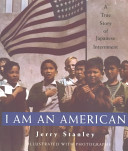Illustrated with black-and-white photographs. Young Shi Nomura was among the 120,000 American citizens who lost everything when he was sent by the U.S. government to Manzanar, an interment camp in the California desert, simply because he was of Japanese ancestry. “In clear and fascinating prose, Stanley has set forth the compelling story of one of America’s darkest times–the internment of Japanese-Americans during World War II. His meticulously researched volume is accompanied by numerous, fine period black-and-white photographs…This eloquent account of the disastrous results of racial prejudice stands as a reminder to us in today’s pluralistic society.”
— “School Library Journal” (starred)
-
Sexual Content - 0/5
0/5
-
Violence - 1/5
1/5
-
Language - 1/5
1/5
-
Drugs and Alcohol - 0/5
0/5
Summary
Prior to WWII, thousands of people of Japanese ancestry lived and worked in the United States. Some, known as Issei, had immigrated from their home country of Japan, while others, known as Nisei, were born in the U. S. and were citizens. Following the Japanese attack on Pearl Harbor, government officials began to question the loyalty of all people of Japanese heritage regardless of their citizenship status. Soon after, 120,000 Japanese, two-thirds of whom were Nisei, were forced into internment camps and stripped of their civil rights, despite having committed no crime or broken any law. I Am an American chronicles this internment, focusing on the story of one Japanese American young man, Shiro Nomura, who was a high school student at the time. Shiro had been dating and was in love with a young girl, and they’d planned to be married after graduating, but each of them was sent to a different internment camp. Shiro tried to get transferred to the camp she was in, but by the time they were reunited, her feelings had changed, upending his plans and causing heartbreak.
I Am an American looks at Japanese internment in a broader historical context with regards to the war as well as what it was like for Japanese people both before and following the war. But it also presents a more intimate portrait of Shiro Nomura, as well as his girlfriend, Amy Hattori, and the woman he eventually married, Mary Kageyama. The book presents details of their lives before, during, and after internment, while also talking more generally about what life was like in the internment camps. It also focuses on the racism experienced by Japanese Americans in spite of them going to great lengths to prove their loyalty to their country. Even those who’d served in the U. S. military weren’t exempted from this inhumanity. The only slight misgiving I had with the book was how the author frequently quoted white people who used a racist slur. I commend the author for pointing out that it was a slur, so that kids hopefully won’t get the wrong idea and start using it themselves. I also like that he tried to balance these stories of racism with those of white people who supported Japanese Americans, as well as the fact that he pretty unequivocally expressed the injustice of it all. However, a part of me wonders how a child or teen of Japanese ancestry might feel if reading the book and seeing these slurs. This led me to muse on whether there might have been a way to soften the language a bit, given that even I, as a white adult, felt uncomfortable while reading these quotes. I grudgingly admit, though, that the shock value of it does help drive home how terrible and unjust it was for the Japanese Americans experiencing it. My only other concern, given that this is a book aimed at middle-schoolers and perhaps young teens, is the brief mention of a Japanese man committing suicide when he found out that people like him were to be interned. Otherwise, I think this is a great book for teaching kids and teens about this often overlooked and shameful piece of American history. I learned a number of things while reading it that I didn’t previously know, so I know that it would be informative to young people as well.
Review provided by The Hope Chest Reviews

